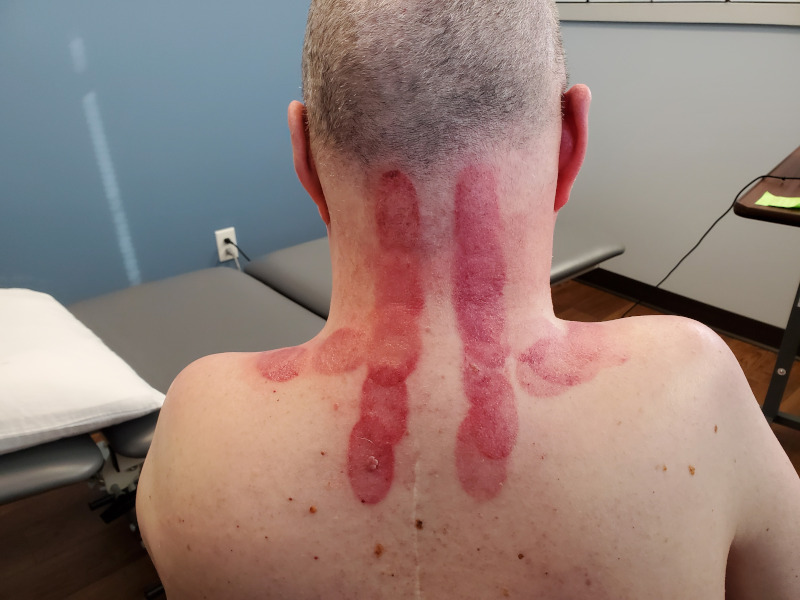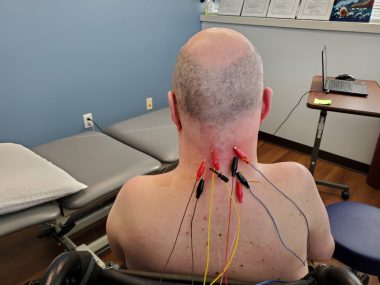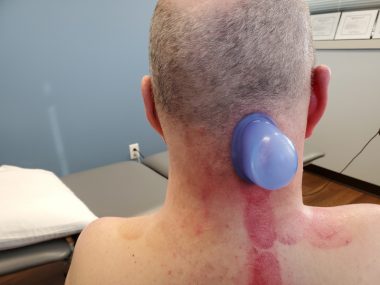Needling and Cupping in Neck and Upper Trapezius for SMA Patients
Cupping has reduced stiffness at patient's end ranges

Michael shows the bruising after the cupping and dry needling procedure. Photo by Emily Jones
Previously, we have performed cupping and dry needling on different parts of Michael’s body to help with several ailments throughout his time in physical therapy. Recently, cupping has helped reduce pain and increase the range of motion in his cervical spine, or neck. Michael reported after cupping he had improved mobility with reduced complaints of stiffness at his end ranges. With these improvements, we decided to incorporate dry needling prior to cupping in his cervical region to increase these improvements.

Electrodes are hooked up to needles in Michael’s neck. The electrodes send pulses of electricity to the muscles. (Photo by Emily Jones)
Dry needling was performed with Michael sitting in his wheelchair. It’s not the preferred position, but it is the only position he is able to maintain for prolonged periods. We also were certain he would be able to resist movement in a safe manner during the activity. The needles were placed along his cervical paraspinals, which is a muscle group that lies directly lateral to the spine and electrical stimulation was applied to help give extra twitching to the muscle group to increase the relaxation and increase the length of the muscles.

Emily started cupping the back of Michael’s neck down through his shoulders. (Photo by Emily Jones)
After the needles were removed, a small amount of lotion was applied for the cupping. The cups were left in each position for about two minutes to increase blood flow to the area and continue to improve mobility and elongate the muscles. Michael has a significant reduction in mobility of his cervical spine, even though he is only fused from his thoracic spine down. It is important to continue to increase his cervical motion to ensure he has as much mobility as allowed to increase his safety awareness and ability to scan the environment.
Michael uses a motorized wheelchair all day, and he needs to be able to look around to ensure the area he is navigating is safe. Increasing Michael’s cervical mobility increases his independence, which is important to him. If he isn’t able to scan his environment in a safe manner, he would need someone with him everywhere he goes. We will continue to perform these activities monthly as he continues to notice his improvements. Once we have plateaued in progress, these techniques will be performed as needed.
Patient perspective
My normal workday usually consists of sitting in front of my computer and monitors for more than eight hours a day. I have two monitors on the bottom, and one monitor centered above the two lower monitors. As the day progresses, I noticed my neck and shoulders were becoming fatigued. Emily then started performing dry needling on my neck and trapezius muscles and also providing electrical stimulation to these muscles as well. After the dry needling, she then cups my neck and shoulders to increase the amount of blood flow to these particular muscles. I noticed a huge difference in the way my neck and shoulders feel, and I’m much less fatigued after a long day.
While these images may look somewhat gruesome, the dry needling and cupping actually feel very good, and it doesn’t take me long to notice the difference in how I feel. This is definitely something Emily will continue performing either twice a month or on a monthly basis. As she mentioned above, once we reach the plateau with regards to progress, she will only perform these procedures on me on an as-needed basis.



